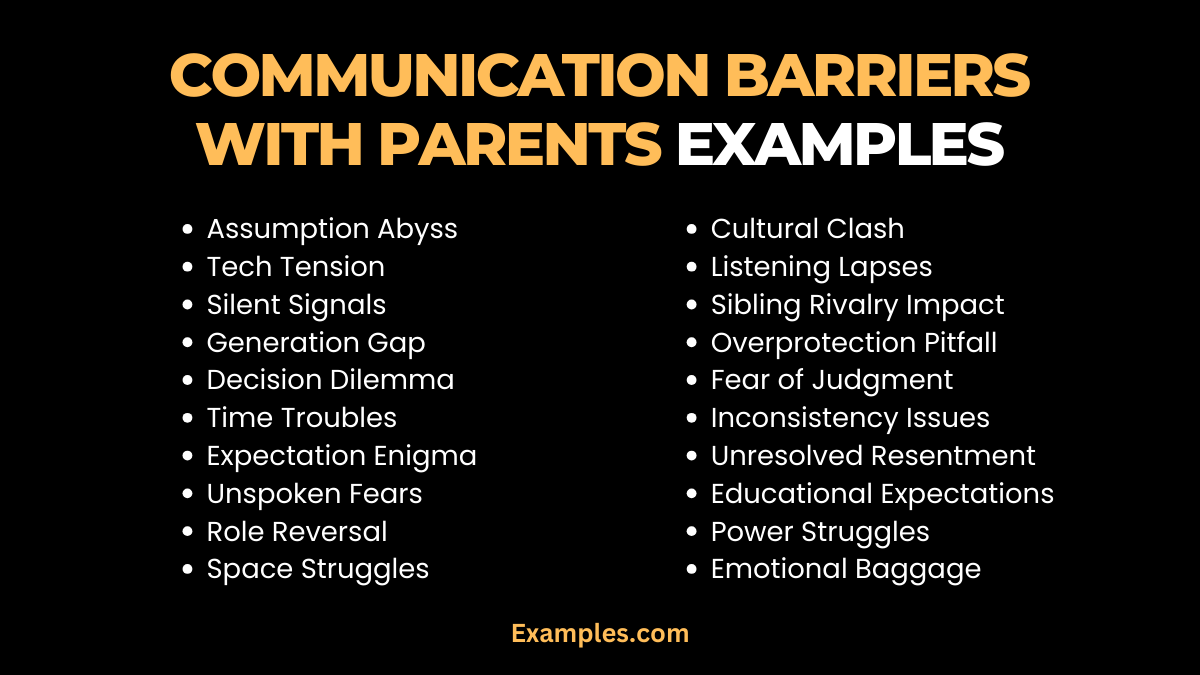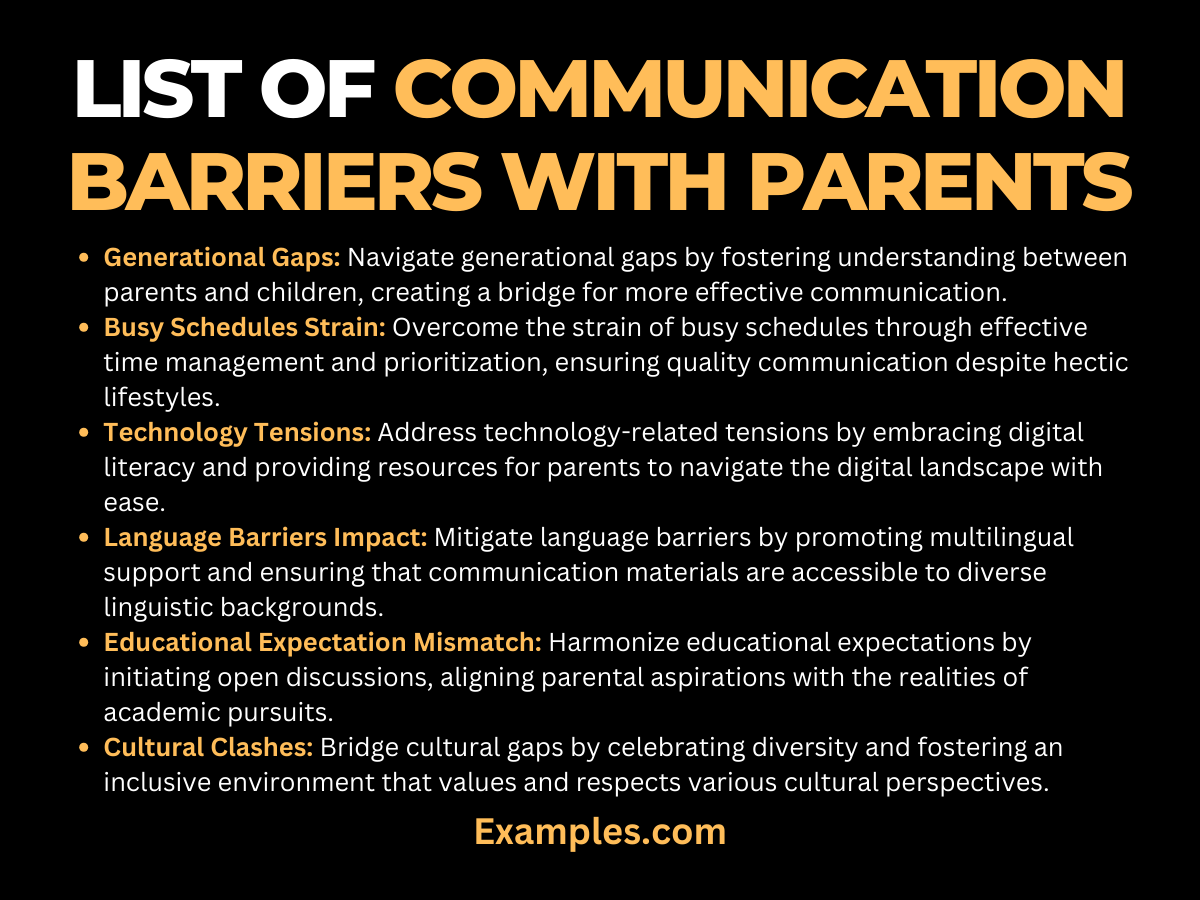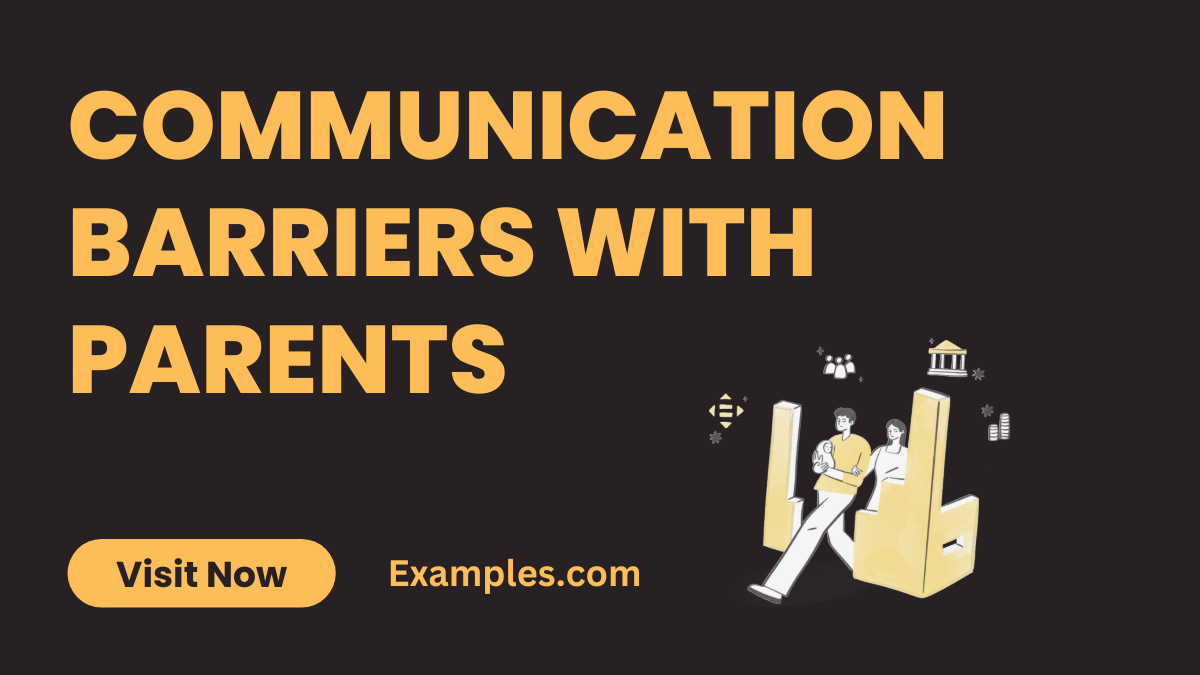19+ Communication Barriers with Parents Examples
Discover a comprehensive guide to surmounting communication barriers with parents. This detailed exploration not only sheds light on common challenges but also provides illuminating communication examples to empower you. Navigate through effective strategies and valuable insights, transforming hurdles into opportunities for meaningful connections. Elevate your communication skills and foster stronger relationships with our in-depth exploration of Communication Barriers with Parents. Uncover the power of dialogue through practical examples in this essential guide.
What is Communication Barriers with Parents?

Communication barriers with parents refer to obstacles that hinder effective understanding and exchange of information between parents and their children. These barriers can manifest as misunderstandings, differing communication styles, or generational gaps. Overcoming these challenges is crucial for fostering healthy relationships and ensuring open, meaningful dialogues within the family. In simpler terms, communication barriers with parents encompass any factors that impede clear and effective communication between parents and their children.
Best Example of Communication Barriers with Parents
Consider a common scenario where a teenager struggles to express their emotions to their parents. The parent, preoccupied with daily responsibilities, may misinterpret the silence as disinterest rather than a communication barrier. In this instance, the barrier lies in the difference of perspectives and the unspoken emotional needs of the teenager. This example highlights the importance of recognizing and addressing subtle cues, fostering open communication, and bridging the gap between generations for a healthier parent-child relationship.
20 Communication Barriers with Parents Examples:

Explore a rich array of 20 communication barriers with parents examples in this comprehensive guide. Uncover practical insights and effective strategies to navigate these challenges, fostering stronger connections within your family. Each example is carefully crafted to provide a unique perspective, ensuring a deeper understanding of potential hurdles in parent-child communication.
- Assumption Abyss: When assuming parental expectations, children may withhold thoughts. Address assumptions through open dialogue, creating a more transparent atmosphere.
- Tech Tension: Differing views on screen time can lead to conflicts. Finding common ground promotes healthy discussions about technology usage.
- Silent Signals: Unspoken emotions create a barrier. Encourage expressive conversations to decode silent signals and strengthen emotional bonds.
- Generation Gap: Divergent cultural references can hinder understanding. Bridge the gap through shared experiences, fostering mutual appreciation.
- Decision Dilemma: Conflicting opinions on decisions can strain relationships. Seek compromise and involve all parties to enhance decision-making harmony.
- Time Troubles: Busy schedules may limit quality time. Prioritize family moments, diminishing the barrier caused by time constraints.
- Expectation Enigma: Mismatched expectations lead to misunderstandings. Clarify expectations openly to create a shared understanding within the family.
- Unspoken Fears: Unaddressed fears can hinder open discussions. Provide a safe space for vulnerability, allowing fears to be expressed without judgment.
- Role Reversal: Fluctuating parent-child roles may cause confusion. Establish clear roles while encouraging flexibility for a balanced dynamic.
- Space Struggles: Invasion of personal space can cause discomfort. Respecting boundaries fosters a healthy balance between connection and independence.
- Cultural Clash: Cultural differences may lead to misunderstandings. Embrace diversity, encouraging discussions to appreciate each other’s backgrounds.
- Listening Lapses: Inattentive listening can create communication gaps. Cultivate active listening skills to strengthen understanding and connection.
- Sibling Rivalry Impact: Sibling conflicts affect overall communication. Addressing rivalry dynamics positively impacts the family communication climate.
- Overprotection Pitfall: Excessive protection can stifle independence. Balancing guidance with autonomy encourages open communication about needs and boundaries.
- Fear of Judgment: Fear of parental judgment inhibits honesty. Establish a non-judgmental environment to foster open conversations without apprehension.
- Inconsistency Issues: Inconsistent expectations create confusion. Establish clear and consistent guidelines to promote stability and understanding.
- Unresolved Resentment: Unresolved conflicts breed resentment. Addressing issues promptly prevents lingering negative emotions from hindering communication.
- Educational Expectations: Differing views on academic achievements can create tension. Encourage open discussions to align expectations and support educational goals.
- Power Struggles: Parent-child power dynamics may disrupt communication. Promote a collaborative approach to problem-solving, fostering mutual respect.
- Emotional Baggage: Unresolved emotions from the past affect present interactions. Acknowledge and address emotional baggage to pave the way for healthier communication.
Communication Barriers with Parents in School:
Explore the complexities of parent-school communication barriers. This guide offers actionable strategies and real-life examples to enhance collaboration for a supportive educational environment.
- Expectation Misalignment: Align parental expectations with school outcomes through regular discussions on academic goals.
- Language Divide: Bridge language gaps for non-native English speakers with translated materials and language support.
- Extracurricular Disconnect: Foster parent engagement in extracurricular activities with informative sessions and benefits showcases.
- Digital Access Hurdle: Overcome technology gaps by providing accessible digital resources for inclusive virtual communication.
- Jargon Simplification: Simplify educational jargon with explanations and examples for clearer understanding of classroom discussions.
- Feedback Clarity: Provide clear and constructive feedback to prevent misinterpretations and support the child’s educational journey.
- Cultural Awareness Focus: Promote cultural awareness through events, fostering an inclusive environment for diverse parental perspectives.
- Flexible Communication Channels: Accommodate busy schedules with flexible communication channels, ensuring active parental participation in school affairs.
- Homework Assistance Support: Offer workshops and resources to guide parents in effective ways to support their children’s learning at home.
- Tech Literacy Training: Enhance digital literacy with training sessions, empowering parents to navigate and engage with online learning platforms.
Common Barriers to Communication Between Parents and Teachers:
Delve into the common barriers hindering effective communication between parents and teachers. This insightful guide explores practical solutions and real-life examples, offering strategies to foster collaboration for the benefit of a child’s education.
- Time Constraints Challenge: Mitigate time constraints by scheduling regular parent-teacher meetings and utilizing digital communication tools for efficient updates.
- Assumption Pitfall: Avoid misunderstandings caused by assumptions through open communication, ensuring clarity on both parental and teacher expectations.
- Inconsistent Information Flow: Establish consistent channels for information flow to prevent confusion, fostering a reliable and transparent communication process.
- Language Barriers Impact: Overcome language barriers with translated materials and multilingual support, facilitating seamless communication for all involved parties.
- Feedback Interpretation Differences: Align feedback interpretation by providing clear and constructive comments, promoting a shared understanding of a child’s progress.
- Educational Jargon Confusion: Demystify educational jargon with explanations, creating a more accessible communication environment for parents to engage in.
- Cultural Misunderstandings: Bridge cultural gaps through awareness initiatives, fostering an inclusive environment that values diverse perspectives in parent-teacher communication.
- Technology Gap Challenge: Address technology gaps by offering training sessions, enhancing digital literacy for parents to engage effectively in online communication platforms.
- Lack of Parental Involvement: Encourage parental involvement through engaging activities, creating opportunities for collaboration and shared decision-making in a child’s education.
- Misaligned Educational Goals: Align parental and educational goals through collaborative discussions, ensuring a shared vision for a child’s academic success.
List of Communication Barriers with Parents

Explore a comprehensive list of communication barriers with parents, unveiling the challenges that may hinder effective dialogue. This guide not only identifies these hurdles but also offers practical insights and real-life examples, empowering you to navigate and overcome these obstacles for improved parent-child communication.
- Generational Gaps: Navigate generational gaps by fostering understanding between parents and children, creating a bridge for more effective communication.
- Busy Schedules Strain: Overcome the strain of busy schedules through effective time management and prioritization, ensuring quality communication despite hectic lifestyles.
- Technology Tensions: Address technology-related tensions by embracing digital literacy and providing resources for parents to navigate the digital landscape with ease.
- Language Barriers Impact: Mitigate language barriers by promoting multilingual support and ensuring that communication materials are accessible to diverse linguistic backgrounds.
- Educational Expectation Mismatch: Harmonize educational expectations by initiating open discussions, aligning parental aspirations with the realities of academic pursuits.
- Cultural Clashes: Bridge cultural gaps by celebrating diversity and fostering an inclusive environment that values and respects various cultural perspectives.
- Parental Involvement Hurdles: Encourage parental involvement by creating opportunities for participation in school activities and decision-making processes, fostering a collaborative educational journey.
- Assumption Pitfall: Avoid the pitfalls of assumptions by promoting transparent communication, ensuring that expectations are clearly articulated and understood by all parties.
- Ineffective Feedback Loops: Enhance feedback loops by establishing consistent channels for communication, allowing for ongoing and constructive dialogue between parents and educators.
- Mismatched Communication Styles: Harmonize communication styles by recognizing and adapting to the preferences of both parents and children, fostering a more connected and cohesive family dynamic
How to Break Down Communication Barriers Between Teachers and Parents?
Effective communication between teachers and parents is vital for a child’s academic success. This guide provides actionable strategies to dismantle barriers, fostering a collaborative and supportive educational environment.
- Establish Open Channels: Create accessible communication channels, ensuring both teachers and parents feel comfortable reaching out, whether through emails, meetings, or digital platforms.
- Promote Active Listening: Cultivate active listening skills among teachers and parents, fostering understanding and empathy to address concerns and suggestions effectively.
- Clarify Expectations: Facilitate clear expectations by openly discussing academic goals, behavioral expectations, and communication preferences to align visions for the child’s development.
- Utilize Technology Wisely: Embrace technology for efficient communication. Implement user-friendly platforms and tools, ensuring seamless information flow between teachers and parents.
- Encourage Regular Updates: Establish a routine for sharing updates on a child’s progress, achievements, and areas for improvement, fostering consistent and transparent communication.
- Offer Language Support: Address language barriers by providing translated materials and multilingual support, ensuring that all parents can engage effectively in the communication process.
- Host Inclusive Events: Organize events that promote inclusivity, celebrating diverse cultures and perspectives, and providing opportunities for teachers and parents to interact in a relaxed setting.
- Provide Resources for Understanding: Offer resources that help parents understand educational jargon, curriculum changes, and teaching methods, promoting clearer communication and involvement in a child’s education.
- Encourage Face-to-Face Meetings: Schedule regular face-to-face meetings to build a personal connection, fostering trust and collaboration between teachers and parents.
- Establish a Feedback Loop: Create a constructive feedback loop by encouraging both teachers and parents to share insights, concerns, and suggestions, ensuring continuous improvement in the communication process.
In conclusion, navigating communication barriers with parents is essential for fostering strong, supportive relationships. This guide has illuminated practical examples and strategies to overcome obstacles, ensuring open and effective dialogue. By understanding and addressing these challenges, parents and children can build stronger connections, enhancing the overall family dynamic and creating a more enriching environment for communication and understanding.



